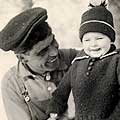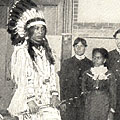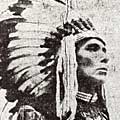
Most northeastern Native people living at the turn of the twentieth century had adapted elements of white culture alongside traditional customs and beliefs. Native people were often invisible to their neighbors unless they were seen demonstrating Indian crafts, speaking Indian languages, or performing in stereotypical Indian "costume."
During this era of deep prejudice against Native Americans and other people of color it was often dangerous to talk about one's Native ethnicity. In Vermont and New Hampshire, the Eugenics Project started sterilizing Native people and other "undesirables." Even white reformers argued that Native people could survive only by rejecting their own culture and beliefs and assimilating into white society. Dozens of special boarding schools established for this purpose housed thousands of Native children wrenched from their families and cultures.
Paradoxically, non-Natives continued to seek out romantic and exotic ways to interact with Native culture even as they insisted that actual Native peoples conform to the dominant American culture.
Elisabeth Sadoques, Abenaki (Wabenaki) woman, circa 1925
Photo Credit: "Portrait of Elisabeth Sadoques used with permission of Mali Keating courtesy of Lynn Murphy."
|








